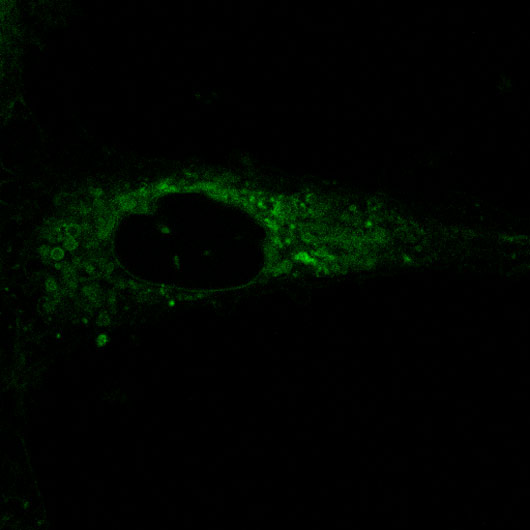Understanding Alzheimer’s

Microscope images of fluorescing cells captured by researcher Kirsty Muirhead.
Scottish scientists have made an important breakthrough in understanding how Alzheimer’s disease takes hold of the brain.
The researchers at the University of St Andrews have found a new way of studying the enzyme that has been implicated in the development of the debilitating disease.
Supported by the Alzheimer’s Research Trust, the group hope to use their findings to help design a drug that could potentially stop Alzheimer’s in its tracks.
The development has been described as ‘an exciting step forward for dementia research’ by the ART, the UK’s leading dementia research charity.
The new development involves the use of a new fluorescent tracking chemical that reacts with the enzyme inside living cells.
As part of the project, St Andrews’ PhD student Kirsty Muirhead – funded by an £84,743 grant from the charity – has been collaborating with scientists across the globe to use the chemical for studying Alzheimer’s disease.
The enzyme, known as amyloid-binding alcohol dehydrogenase (ABAD), normally helps the brain cells produce energy, but in people with Alzheimer’s disease, a toxic protein called amyloid binds onto the enzyme, stopping it from working properly.
Using the new chemical, the researchers have been able to see this process under the microscope for the first time.
Alzheimer’s disease is the most common cause of dementia, a condition that currently affects nearly 4,000 people in Fife alone.
Miss Muirhead, 25, said, “Our ultimate aim is to stop amyloid binding onto ABAD, which will allow the enzyme to do its job, but before we can do that, we have to be able to measure what is happening inside the cell. This is the first time it has been possible to see the interaction inside living cells.
“I chose to work on this project because I wanted to do something that was going to have a benefit for people, so I’m very excited about this progress.”
Her supervisor, Dr Frank Gunn-Moore, commented, “This work marks an important development for us, and has partly been made possible because scientists from different fields have come together to share their knowledge. Indeed this has been a team effort from ourselves here in St Andrews and Kirsty’s co-supervisor Dr Stuart Conway at the University of Oxford.
“We now hope to build on this success by finding a chemical that could stop amyloid and ABAD binding, which could in turn help us design an effective treatment for Alzheimer’s.”
The research is published online by the journal ACS Chemical Biology.
Ends
Note to Editors
Dr Frank Gunn-Moore is available for interview today on 01334 463525.
For further information on the Alzheimer’s Research Trust contact Kirsty Marais, Media Officer on 01223 843304, 07826 559233 or email [email protected]
Category Research